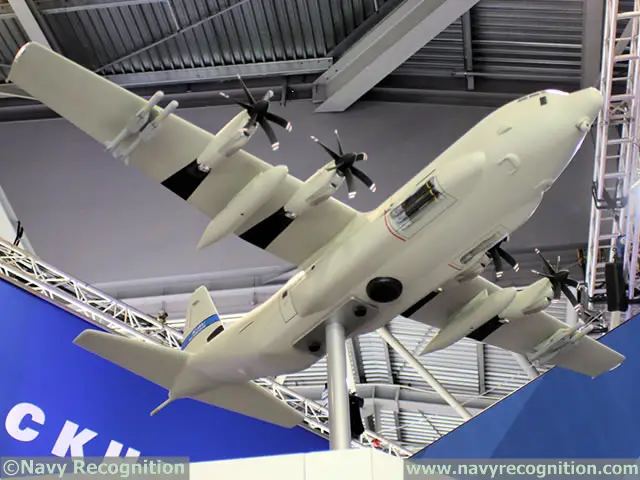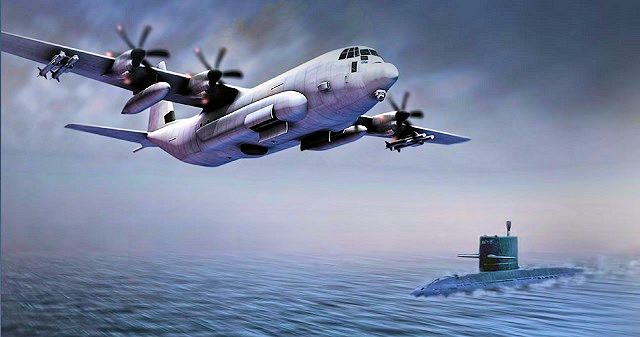Breaking news
Lockheed Sees its SC-130J Sea Herc as The Affordable Solution to Answer UK Future MPA Needs.
| 2015
 SC-130J Sea Herc MPRA Scale Model on Lockheed Martin Stand at DSEI 2015
SC-130J Sea Herc MPRA Scale Model on Lockheed Martin Stand at DSEI 2015 |
|||
Lockheed
Martin strongly believes it has the most cost effective solution as its
plan is to convert up to 10 short fuselage C-130J Hercules. We were explained
that these 10 Royal Air Force aircraft are to be taken out of service
starting in 2016 as part of the latest SDSR (Uk's Strategic Defence and
Security Review). Lockheed stresses that there is still plenty of flight
hours left in these 10 transport aircraft. Another factor that contributes to the SC-130J affordability is its commonality with the existing Royal Navy Merlin Mk2: Lockheed plans to use the same mission systems of the Merlin onboard the Sea Herc. While the Merlin has two operator consoles, the SC-130J would be fitted with 5 similar workstations in a palletized roll on roll off payload. This way the SC-130J would still have the ability to conduct transport missions. Finally, Lockheed Martin insists the Sea Herc is a truly UK solution as 80% of the work to be conducted on the SC-130J would be done in the United Kingdom. |
|||
 Operator consoles aboard the Royal Navy Merlin Mk2 Helicopter present at DSEI 2015. Lockheed Martin plan to fit five of the same consoles on the SC-130J Sea herc. |
|||
Lockheed
Martin thinks the UK MPA requirement will include capability to conduct
missions over sea as well as land. MPAs don't have to be limited to the
maritime domain: For example, French Navy ATL2 MPA routinely deploy on
missions above Iraq where their ISR sensors prove effective to support
fighters on the ground and in the air alike. Lockheed says its C-130 range
has already proven its ability to conduct combat missions thanks to the
KC-130J Harvest Hawk variant, which is fitted with a weapon mission kit
including AGM-114 Hellfires air to ground missions. Specific equipment fitted on the SC-130J includes a belly mounted radar (we asked if the radar may be Thales new Searchmaster but we were told that no radar selection has been made yet and that Lockheed may integrate any type of radar chosen by the British MoD), EO/IR sensors and an optional MAD (magnetic anomaly detector) at the tail. |
|||
 Detailed view: Up to 3 torpedo may be fitted per conformal sponson. The SC-130J is fitted with an underbelly radar and EO/IR sensor under the nose. |
|||
To
deploy effectors, SC-130J is fitted with two conformal sponsons for 4
to 6 torpedoes and with underwing pylons for two anti-ship missiles or
four air-to-ground missiles (per pylon). A carousel is fitted Inside the
aircraft to drop sonobuyos. To facilitate the work of operators during
ASW missions, Lockheed Martin has developed an acoustic sound proofing
to reduce the sound level inside the aircraft. Navy Recognition learned that a scale model of the Sea Herc was tested last year in a wind tunnel facility in the United States. Regarding performance, thanks to its long range fuel tanks, the SC-130J is expected to have a 13.7 hours endurance, meaning it can deploy 1000 miles from its base and remains on station for 6.5 hours before returning to base. This can be extended with air refueling. Finally, Lockheed Martin believes another advantage of the Sea Herc over its turbo fan equipped competitors (namely the Boeing P-8 Poseidon and Japanese P-1) is the ability to operate from shorter or even austere runways. |
|||
 Artist Impression: SC-130J Sea Herc MPRA on patrol. Image: Lockheed Martin |
|||


























